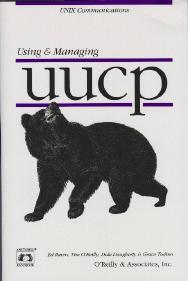
You may not be familiar with this relic of the Stone Age of computing, but even if you are, our good friends at O'Reilly & Associates have created just the companion you need: Using & Managing UUCP.

Author: Ed Ravin,Tim O'Reilly, Dale Dougherty & Grace Todino
Publisher: O'Reilly & Associates, Inc.
Price: $29.95
ISBN: 1-56592-153-4
Reviewer: Charles Stuart
Have you ever had to transfer large amounts of information between your Linux box and a XENIX system? I have. Unfortunately, XENIX doesn't support TCP/IP without additional software. The tar and compress commands are crippled. I eventually found a precompiled copy of Kermit, but there were hundreds of files to transfer. Late-night caffeine overload just wouldn't take me where I had to go.
The solution to my particular dilemma was UUCP, the Unix-to-Unix copy program. You may not be familiar with this relic of the Stone Age of computing, but even if you are, our good friends at O'Reilly & Associates have created just the companion you need: Using & Managing UUCP. This tome is a consolidation of two older O'Reilly volumes, Managing UUCP & USENET and Using UUCP & USENET. I was looking for UUCP information exactly at the time the two older books were being superseded by the new, and I ended up searching for Managing UUCP & USENET for quite a while with no success. The new book wasn't available yet and I could find no other reference that promised as much information, so I ordered a copy from the local bookstore before it was even released. As with every other O'Reilly book in my library, Using & Managing UUCP is readable enough for background information, extensive enough for a reference and visually attractive.
The book's organization is straightforward. The first half covers UUCP programs and commands, including such details as how your shell affects command syntax. It dives right into UUCP usage with copious examples of command syntax and results. The style lends itself to experimentation with commands while reading the text and presents commands in the order in which a novice is most likely to need them.
The first section of the book was very useful for me, but it was the promise of the second section that sent me scurrying out with credit card in hand. Most of us in the Linux world are our own system administrators and gurus, and I'm no exception. There was no one handy to ask about UUCP setup, and the documentation for Linux would not help me with the idiosyncrasies of a legacy system. It is in this area that Using & Managing UUCP shines. System-specific issues are sprinkled throughout the text, and cover the gamut of current Unix operating systems. The discussion of serial ports, device files and system dependencies is quite useful, particularly the information on enabling serial ports for login under various Unices. The major flaw of the second section is that the level of assumed knowledge is pretty high. If you don't know about serial communications and Unix initialization, be prepared for a steep learning curve.
No book review would be complete without a little nit-picking, and I have a few. First is the apparent deletion of the truly archaic information specific to some Unix variants. UUCP has been around a long time, and legacy systems running old code are common. I ordered this book based on the description of Managing UUCP & USENET on O'Reilly's web site, and information about older systems was the main reason I wanted it. Another (small) nit is the lack of a good introductory section describing program versions in the wild. This information does appear at the beginning of the second section of the book, but by that time the novice's head is already spinning. Finally, the organization of the technical information is a little haphazard. This may make the book more readable, but less useful as a reference or problem solving guide. I would have preferred to see system-specific information placed in its own chapter.
Linux users already have several good sources of information regarding UUCP setup: the Network Administrators Guide, the UUCP HOWTO and the Serial HOWTO. If you have to set up UUCP between two Linux boxes and these guides do the trick for you, you need go no further. However, if you have to work with non-Linux systems and want more in-depth information or run into problems, Using & Managing UUCP is worth the cost.